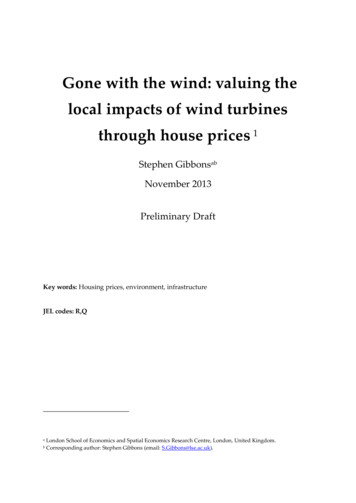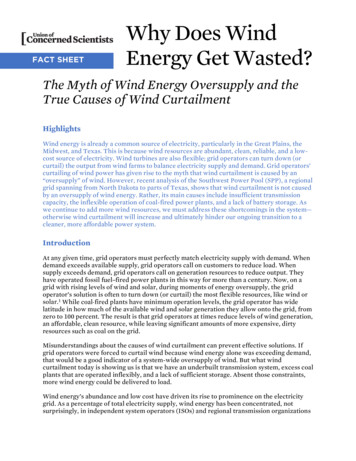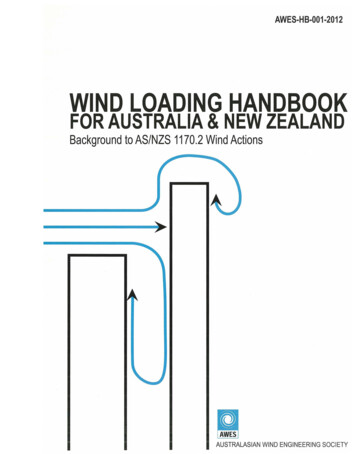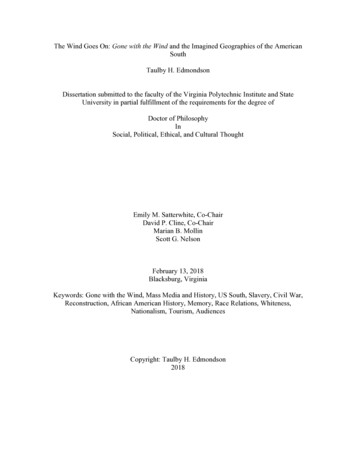
Transcription
Gone with the wind: valuing thelocal impacts of wind turbinesthrough house prices 1Stephen GibbonsabNovember 2013Preliminary DraftKey words: Housing prices, environment, infrastructureJEL codes: R,QabLondon School of Economics and Spatial Economics Research Centre, London, United Kingdom.Corresponding author: Stephen Gibbons (email: S.Gibbons@lse.ac.uk).
1IntroductionRenewable energy technology provides potential global environmental benefits in terms ofreduced CO2 emissions and slower depletion of natural energy resources. However, like mostpower generation and transmission infrastructure, the plant, access services and transmissionequipment associated with renewable electricity generation may involve environmental costs. Thisis particularly so in the case of wind turbine developments, where the sites that are optimal interms of energy efficiency are typically in rural, coastal and wilderness locations that offer manynatural environmental amenities. These natural amenities include the aesthetic appeal oflandscape, outdoor recreational opportunities and the existence values of wilderness habitats. Inaddition, residents local to operational wind turbines have reported health effects related to visualdisturbance and noise (e.g. Bakker et al 2012, Farbouda et al 2013).The UK, like other areas in Europe and parts of the US has seen a rapid expansion in the numberof these wind turbine developments since the mid-1990s. Although these ‘wind farms’ can offervarious local community benefits, including shared ownership schemes and the rents to landowners, in the UK, and elsewhere in Europe, wind farm developments have faced significantopposition from local residents and other stakeholders with interests in environmentalpreservation. This opposition suggests that the environmental costs may be important. This is acontroversial issue, given that opinion polls and other surveys generally indicate majority supportof around 70% for green energy, including windfarms, (e.g. results from the Eurobarometer surveyin European Commission 2006). This contradiction has led to accusations of ‘nimbyism’ (not in mybackyard-ism), on the assumption that it is the same people opposing windfarm developments inpractice as supporting them in principle. There is a perhaps less of a contradiction when it isconsidered that the development of windfarms in rural locations potentially represents a transferfrom residents in these communities and users of natural amenities (in the form of loss of-1-
amenities) to the majority of the population who are urban residents (in the form of energy). Otherpossible explanations for the tension between public support and private opposition to windenergy developments are discussed at length in Bell et al (2007).This paper provides quantitative evidence on the local benefits and costs of wind farmdevelopments. In the tradition of studies in environmental, public and urban economics, housingcosts are used to reveal local preferences for wind farm development in England and Wales. This isfeasible in England and Wales because wind farms are increasingly encroaching on rural, semirural and even urban residential areas in terms of their proximity and visibility, so the contextprovides a large sample of housing sales that potentially affected (at the time of writing, around2.5% of residential postcodes are within 4 km of operational or proposed wind farmdevelopments). Estimation is based on quasi experimental, difference-in-difference based researchdesigns that compare price changes in postcodes close to wind farms when wind farms becomeoperational with postcodes various comparator groups. These comparator groups include: placesclose to wind farms that became operational in the past, or where they will become operational inthe future; places close to wind farms sites that are in the planning process but are not yetoperational; places close to where wind farms became operational but where the turbines arehidden by the terrain; and places where wind farm proposals have been withdrawn or refusedplanning permission. The postcode fixed effects design implies that the analysis is based on repeatsales of the same, or similar housing units within postcode groups (typically 17 houses groupedtogether).All these comparisons suggest that operational wind farm developments reduce prices in locationswhere the turbines are visible, and that the effects are causal. This price reduction is around 5-6%for housing with a visible wind farm of average size (11 turbines) within 2km, falling to 3% within-2-
4km, and to 1% or less by 14km which is at the limit of likely visibility. Evidence from comparisonswith places close to wind farms, but where wind farms are less visible suggests that most if not allof these price reductions are directly attributable to turbine visibility.The remainder of the paper is structured as follows. Section 2 discusses background policy issuesand the existing literature on wind farm effects. Section 3 outlines the data used for the analysis.Section 4 describes the empirical strategy and Section 5 the results. Finally, Section 6 concludes.2Wind farm policy and the literature on their local effectsIn England and Wales, many wind farms are developed, operated and owned by one of a numberof major energy generation companies, such as RES, Scottish Power, EDF and E.ON, Ecotricity,Peel Energy, though some are developed as one-off enterprises or agricultural farms. Currently,wind farms are potentially attractive businesses for developers and landowners because theelectricity they generate is eligible for Renewables Obligation Certificates, which are issued by thesector regulator (Ofgem) and guarantee a price at premium above the market rate. This premiumprice is subsidised by a tariff on consumer energy bills. The owners of the land on which a windfarms is constructed and operational will charge a rent to the wind farm operator. Media reportssuggest that this rent could amount to about 40,000 per annum per 3 MW turbine (Vidal 2012).The details of the procedures for on-shore wind farm developments in England and Wales haveevolved over time, but the general arrangement is that applications – in common with applicationsfor most other types of development - have to pass through local planning procedures. Theseprocedures are administered by a Local Planning Authority, which is generally the administrativeLocal Authority, or a National Park Authority. Very small single wind turbines (below the scalecovered by the current analysis) can sometimes be constructed at a home, farm or industrial siteswithin the scope of ‘permitted development’ that does not require planning permission. The-3-
planning process can take several years from the initial environmental scoping stage to operation,and involves several stages of planning application, environmental impact assessment, communityconsultation and appeals.2Once approved, construction typically takes 6 to 18 months. Largewind farms (over 50 Mw) need approval by central government. Offshore wind farms are alsosubject to a different process and require approval by a central government body.Wind farms have potential local economic benefits of various types. Interesting qualitative anddescriptive quantitative evidence on the community and local economic development benefits ofwind farms in Wales is provided by Mundlay et al (2011). Potential benefits include the use oflocally manufactured inputs and local labour, discounted electricity supplies, payments intocommunity funds, sponsorship of local events, environmental enhancement projects, and tourismfacilities. They argue that the local economic development effects have been relatively limited,although in many of the communities surveyed (around 21 out of 29 wind farms) payments weremade to community trusts and organisations, and these contributions can be quite substantial – ataround 500- 5000 per megawatt per annum. Based on these figures, a mid-range estimate of thecommunity funds paid out to affected communities in Wales would be about 21,000 per windfarm per year.There is an extensive literature on attitudes to wind farm developments, the social and healthaspects, and findings from impact assessments and planning appeals. Most existing evidence onpreferences is based on surveys of residents’ views, stated preference methods and contingentvaluation studies and is mixed in its findings. There have been some previous attempts to quantifyimpacts on house prices in the US. Hoen et al (2011) apply cross-sectional hedonic analysis, basedE.g. Peel Energy http://www.peelenergy.co.uk/ provide indicative project planning timelines for their proposed windfarm developments2-4-
on 24 wind farms across US states. Their study is interesting in that it makes the comparisonbetween price effects at places where turbines are visible compared to places where nearbytrurbines are non-visible (a technique which is applied later in the current paper) but finds noimpacts. For the UK: Sims et al (2007) also conduct a cross-sectional hedonic analysis of 900property sales, which all postdate construction, near three windfarms in Cornwall. Again thisstudy finds no effects.Few studies have carried out an analysis using difference-in-difference methods to try to establishthe causal impacts of wind farm development. However, such methods have been applied to thevaluation of other types of power infrastructure, for example Davis (2011, Restats) who findsnegative impacts from US power plants. One study to attempt this, and probably the mostcomprehensive previous work on the impacts of wind farms on housing prices, is recent work byHoen at al (2013). Hoen et al look at the effect of 61 wind farms across nine states the US usingdifference in difference style comparisons and some spatial econometric methods, on a sample of51276 transactions. There are, however, very few transactions in the areas near the wind farms:only 1198 transactions reported within 1 mile of current or future turbines (p20). Their regressionsdo not, as far as can be deduced, exploit repeat sales within localised groups below county leveland rely on county fixed effects and sets of housing and geographical control variables. Theconclusions of the paper are that there is ‘no statistical evidence that home values near turbineswere affected’ by wind turbines, which is true in a literal sense. However, the point estimatesindicate quite sizeable negative impacts; it is the fact that the point estimates are imprecise andhave big standard errors that makes them statistically insignificant.In contrast, the current study has 28,951 quarterly, postcode-specific housing price observationsover 12 years, each representing one or more housing transactions within 2km of wind farms-5-
(about 1.25 miles). Turbines are potentially visible in 27,854 of these. There is therefore a muchgreater chance than in previous work of detecting price effects if these are indeed present.3DataInformation on wind-farm location (latitude and longitude), characteristics and dates of eventswas provided by RenewableUK, a not for profit renewable energy trade association (formerlyBWEA). This dataset records dates of operation and other events related to their planning history,number of turbines, MW capacity, height of turbines (to tip). The dates in these data relate to thecurrent status of the wind farm development, namely application for planning, approval,withdrawal or refusal, construction and operation. Unfortunately these data do not provide acomplete record of the history for a given site, because the dates of events are updated as theplanning and construction process progresses. Therefore, for operational sites, the dates ofcommencement of operation are known, but not the date when planning applications weresubmitted, approved or construction began. Dates are also given in the data in relation towithdrawal or refusal of planning applications. For the remaining cases of sites which are not asyet either operational, withdrawn or refused planning permission, the date refers to the latestdevelopment event – either application, approval, or the start of construction. This limits the scopeof investigation of the impact of different events in the planning and operation process, other thanfor cases where there is a final event recorded i.e. that the wind farm is operational, or a planninghas been withdrawn or refused.A GIS digital elevation model (DEM)3 based was combined with this wind-farm site and heightdata to generate ‘viewsheds’ on 200m grid. These viewsheds were used to differentiate residentialGB SRTM Digital Elevation Model 90m, based on the NASA Shuttle Radar Digital Topography Mission and availablefrom the EDNIA ShareGeo service http://www.sharegeo.ac.uk/handle/10672/53-6-
postcodes (geographical units with approximately 17 houses) into those from which the wind farmis visible, and those from which it is less likely they are visible, using information on theunderlying topography of the landscape. These viewsheds provide approximate visibilityindicators, both in terms of the 200m geographical resolution of the view sheds (necessary formanageable computation times), and because they are based on wind-farm centroids, notindividual turbines. This means that in the case of large wind farms, a turbines may be visible fromlocations which the procedure classifies as non-visible, given a large wind turbine array can extendover 1km or more. However, the median wind farm development in the data contains only 6turbines, in which case the errors introduced by basing visibility on site centroids is likely to small.Note the error will in general result in mis-classification of sites from which the turbines aredeemed non-visible, given that if the tip of a turbine at the centroid of the site is visible, it is almostcertain that at least one turbine is visible. The viewsheds also take no account of interveningbuildings, trees and other structures, because Digital Surface Models which take account of suchfeatures are not yet available for the whole of England and Wales. As a further refinement, toeliminate cases where visibility was highly ambiguous, I calculated the rate of change of visibilityfrom one 200m grid cell to the next, and dropped postcodes in cells in the top decile of thisvisibility gradient.Given the focus of this study on the visual impacts of wind farms in rural areas, a number ofsingle-turbine wind farms in urban areas and industrial zones were excluded from the analysis(around 21 operational turbines are dropped). Land cover estimates were used first to restrict theanalysis to wind farms outside zones with continuous urban land cover. Some additional turbineswere eliminated on a case-by-basis where the information available in the wind farm data, andreference to web-based maps and information sources, suggested that turbines were on industrialsites within or close to major urban areas. The land cover at the wind farm centroid was obtained-7-
by overlaying the wind farm site data with 25m grid based land cover data (LandCoverMap 2000from the Centre for Ecology and Hydrology). Land cover was estimated from the modal landcover type in a 250m grid cell enclosing the wind farm centroid. In cases where no mode exists(due to ties), the land cover in the 25 m grid cell enclosing the centroid was used.Housing transactions data comes from the England and Wales Land Registry ‘pricepaid’ housingtransactions data, from January 2000 to the first quarter of 2012. These data include information onsales price, basic property types – detached, semi-detached, terraced or flat/maisonette – whetherthe property is new or second-hand, and whether it is sold on freehold or leasehold basis. Thehousing transactions were geocoded using the address postcode and aggregated to mean values inpostcode-by-quarter cells to create an unbalanced panel of postcodes observed at quarterlyintervals (with gaps in the series for a postcode when there are no transactions in a given quarter).For a small subset of the data, floor area and other attributes of property sales can be merged fromthe Nationwide building society transactions data. Demographic characteristics at Output Area(OA) level from the 2001 Census were merged in based on housing transaction postcodes. Theseadditional characteristics are used in some robustness checks which appear later in the empiricalresults.Postcode and wind farm visibility data were linked by first forming a panel of postcodes atrunning quarterly (3 month) intervals over the period January 2000-March 2012. The cumulativenumber of turbines in the different planning categories, within distance bands of 0-1km, 1-2km, 24km, 4-8km and 8-14km of each postcode was then imputed at quarterly intervals by GIS analysisof the information on site and postcode centroids. The 14km limit is set in part to keep the datasetat a manageable size, but also because as the distance to the wind farm increases, the number ofother potential coincident and confounding factors increases, making any attempt to identify wind-8-
farm impacts less credible. Existing literature based on field work suggests that large turbines arepotentially perceptible up to 20km or more in good visibility conditions, but 10-15km is moretypical for casual observer and details of individual turbines are lost by 8km (University ofNewcastle 2002). In the next step, the site viewsheds were used to determine whether wind-farmsites are visible or not visible from each postcode in each quarter, again using GIS overlaytechniques. Additional GIS analysis with the Digital Elevation Model provided estimates of theelevation, slope and aspect (North, East, South and West in 90 degree intervals) of the terrain ateach postcode. These are potentially important control variables, because places with good viewsof wind farms may have good views generally, be more exposed to wind, or have more favourableaspects, and these factors may have direct effects on housing prices.Finally, the housing transactions and wind farm visibility data was linked by postcode and quarterto create an end product which is an unbalanced panel of postcode-quarter cells, with informationon mean housing prices and characteristics, the cumulative number of visible and non-visibleturbines within the distance bands and in each planning category, plus additional variables onterrain and demographics. Note, prices in quarter t are linked to the turbine data at t-1, so althoughthe price data extends to the first quarter of 2012, only wind farm developments up to the lastquarter of 2011 are utilised. The next section describes the methods that are applied using thesedata to estimate the house price effects of wind farm developments.4Estimation strategiesThe research design involves a number of alternative regression-based ‘difference-in-difference’strategies. These strategies all compare the average change in housing prices in areas where windfarms become operational and visible, with the average change in housing prices in some-9-
comparator group. The starting point for these different approaches is the following basicdifference-in-difference/fixed effects regression specification:ln priceit k (visible, jk dist k , operational )it 1 xit f i, t it(1)kHere price it is the mean housing transaction price in postcode i in quarter t. The variable capturingexposure to wind-farm developments is (visible , j k dist k, operational )it 1 . This is a dummy (1-0)treatment variable, indicating that postcode i has at least one visible-operational turbine between jkand k km distance in the previous quarter. This indicator is essentially an interaction between anindicator that turbines are potentially visible from a postcode (visible), an indicator that theseturbines are within a given distance band (jk dist k), and a ‘post-policy’ indicator which indicatesthat the turbines have been built and become operational (operational). The date of operation istaken as the date around which the price effects are expected to bite, because there is noinformation in the wind farm data on the date when construction started or finished. Since theestimation method exploits differences in average prices between the post-operation and preoperation periods, the exact timing is not critical, although errors are likely to attenuate estimatedprice effects. Note, it is not necessary to explicitly control for the separate components (visible, jk dist k and operational) because these are going to be subsumed through the specification ofgeographical and time fixed effects f i , t described below.The coefficient of interest k is the average effect of wind farm turbines visible within distanceband jk-k on housing prices. The sign of k is ambiguous a priori, since it depends on the neteffects of preferences for views of wind farms, the impact of noise or visual disturbance – at leastfor properties very close to the turbines – and other potential local gains or losses such as shares inprofits, community grants, or employment related to turbine maintenance and services.- 10 -
Two versions of the distance specifications in (1) are used in the empirical work. In the first case,separate regressions are estimated for different values of k (1km, 2km, 4km, 8km, 14km) and jk 0,i.e k estimates the effects of visible wind farms within a radius k. The estimation sample isrestricted to postcodes within distance k. In the second case, a series of distance bands is used (0 distance 1km, 1km distance 2km, 2km distance 4km, 4km distance 8km and 8km distance 14km) in a single regression, and the sample is restricted to postcodes within themaximum 14km. These distance thresholds are chosen somewhat arbitrarily in order to givereasonable detailed delineation of the distance decay close to wind farm sites, while allowing forpotential impacts up towards the limits of visibility.Crucially, specification (1) allows for unobserved components which vary over time and spacef i , t , and these are inevitably correlated with the wind farm visibility indicator. This correlationwith the geographical effects occurs because wind farms are not randomly assigned across spaceand postcodes close to wind farms and where turbines are visible may not be comparable topostcodes further away in terms of the other amenities that affect housing process. The correlationwith the time effects occurs because the number of wind farms is growing over time, so there isobviously a spurious correlation between any general trends in prices over time and the indicatorof wind farm visibility. It is therefore essential to control in a very general way for geographicalfixed effects and time trends.This is done in part by restricting the sample to groups of postcodes that are likely to becomparable to each other in terms of their propensity to have visible wind farm developmentsclose by, and in addition by controlling for postcode fixed effects. Postcode fixed effects areeliminated in (1) using the within-groups estimator (i.e. differences in the variables from postcodespecific means) and common time effects eliminated within the estimation sample using quarter-- 11 -
specific dummies (i.e. for the 48 quarters spanned by the data). Where applicable, separate sets ofyear dummies for each distance band, jk dist k, control for differences in the price trends in thesedifferent distance bands. Additional time varying geographical effects are captured by interactionsbetween year dummies, and dummies for categories of postcode elevation (0-25m, 26-50m, 51-100, 100m), slope (0-0.5%, 0.51-1%, 1.01-1.5%, 1.51-2.5%, 2.5%), and aspect (315-45 degrees, 46-135degrees, 136-225 degrees, 226-316 degrees). These terrain variables are potentially important,because wind farm visibility may depend on the elevation, slope and direction of the land at thepostcode location. Vector x it also includes optional, time varying observable characteristics of thepostcode mean property transactions (proportion of each property type, proportion new,proportion freehold) to control for changes in sample composition.Comparisons can be made with placebo interventions, or other events, using difference-indifference-in-difference methods, in which the effect visible operational turbines ( k ) is comparedwith counterfactual effects estimated from treatment indicators corresponding to other wind farmplanning and visibility categories. These categories are: turbines that might eventually be visiblebut are still in the planning process, wind farms that are operational but hidden from the postcodelocation by the terrain, and turbines that were refused planning permission. These exact details aredescribed in Sections 4.1 to 4.3 below and in the results section.4.1Strategy A: Existing and future wind farms as comparator groupsThe first and simplest approach applies (1) in a setting which focusses only on postcodes withpotentially visible-operational turbines within a given radius, that is postcodes which had visibleturbines within a given distance radius at the beginning of the study period, or will have visibleturbines within these radii or bands by the end of it. More precisely, a postcode is included in thesample for estimating (1) if it has a visible wind turbine development within the specified radius- 12 -
before January 2000 or if turbines become visible over the course of the study period from 2000 to2011. The aim of this sample restriction to postcodes with potentially visible-operational windfarms is to create a group of postcodes, which are similar in respect of: a) being close to sites whichare suitable for wind farm developments, and where the planning and construction process hasbeen completed; and b) in terms of the likelihood of turbines being visible from the postcode’sgeographical location. In this sample of postcodes the treatment indicator equals 1 for at least onequarter over the sample period. A postcode that has, for example, a visible, operational wind farmwithin 4km opening in the last quarter of 2004 will be included in the sample, but will have(visible , 0 dist k, operational )it 1 0 in all quarters up to t corresponding to the first quarter of 2005,and (visible , 0 dist k, operational )it 1 1 in all quarters thereafter. Postcodes with at least onevisible, operational turbine from the beginning of the study period are included in the sample, buthave the indicator (visible , 0 dist k, operational )it 1 1 throughout.Identification of the price effects k therefore comes from the difference between the average pricechange in postcodes associated with the zero-one changes in the treatment indicator at the timeswind farms becomes operational, and the average price change in the control postcodes thatalready have visible wind farms or do not yet have visible wind farms but will do so in the future.Since the estimates control for postcode fixed effects, identification of k comes only frompostcodes that have transaction observations before and after a wind farm becomes operational,although postcodes that had wind farms visible at the start of the study period in 2000 also formpart of the control group. Note that a within-groups estimator, which compares the post-operationaverage price with the pre-operation average price over the whole sample period, is preferable inthis setting to a specification using differences between two time periods, because: a) there isunlikely to be a step-change in prices coincident with wind farm operation, both because price- 13 -
changes evolve slowly, and because buyers may be aware of the turbines before operation; and b)the panel is unbalanced, with missing quarters (and even years) where there are no pricetransactions in a given postcode, so working with differences over specific time intervals withinpostcodes would result in a large reduction in sample size (e.g. a 4 quarter difference can only beobserved in postcodes where there happen to be sales observed 4 quarters apart).Estimation of the distance-band specification version of (1) proceeds in a similar way, but is basedon the sample of postcodes which have a visible operational turbine within the maximum 14kmradius. Separate treatment indicators (visible , j k dist k, operational )it 1 are included in the sameregression for each distance band. To control for different time trends in the different distanceband groups, these distance band regressions include interactions between year dummies, anddummies indicating that a postcode has a wind farm visible and operational, within a givendistance band, in at least one quarter over the study period.4.2Strategy B: placebo tests using wind farm developments in the planning processIt is well known that difference-in-difference based research designs suffer from the problem ofpre-existing differences in trends between the ‘treatment’ and ‘control’ groups. In Strategy A thisproblem is mitigated by using the same postcodes as both treatment and control groups. Postcodeswith existing visible-operational turbines, and postcodes with potentially visible turbines thatbecome visible-operational in the future, provide information on the counterfactual price changesfor postcodes in which turbines have just become visible-operational. In principle, this approachshould not be sensitive to differences in trends between areas targeted for wind farmdevelopments and those that are not. However, this method may not completely take care of moresubtle differential trends in the affected postcodes, e.g. if areas receiving wind farms in earlieryears are on different trends from the areas receiving wind farms in later years, and where the- 14 -
distribution of the start of wind farm operations is not equally distributed over the sample (whichit is not, as evident from Figure 1. These differenti
Gone with the wind: valuing the local impacts of wind turbines through house prices 1 Stephen Gibbonsab November 2013 Preliminary Draft Key words: Housing prices, environment, infrastructure JEL codes: R,Q a London School of Economics and Spatial Economics Research Centre, London, United Kingdom.










